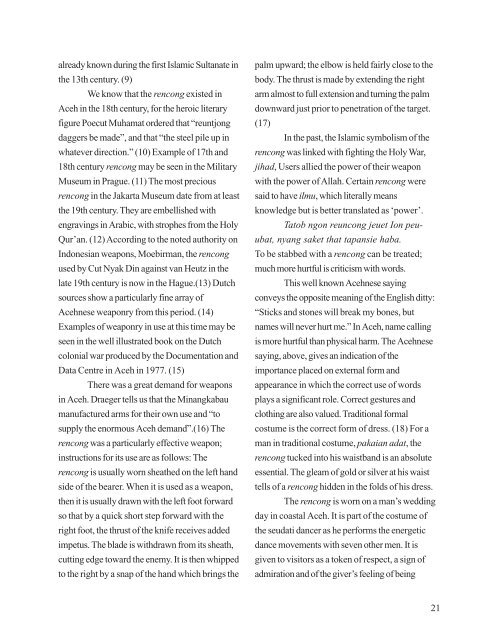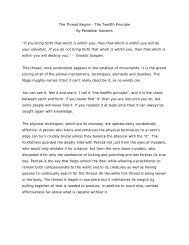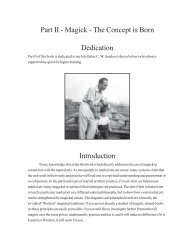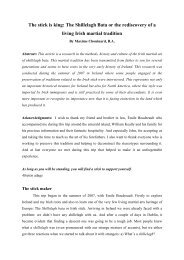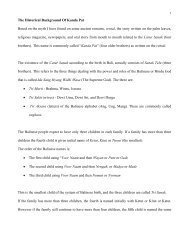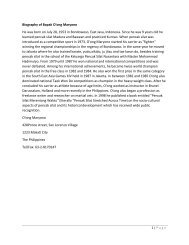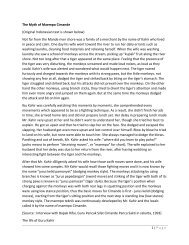Tenaga Dalam - Pukulan Cimande Pusaka
Tenaga Dalam - Pukulan Cimande Pusaka
Tenaga Dalam - Pukulan Cimande Pusaka
You also want an ePaper? Increase the reach of your titles
YUMPU automatically turns print PDFs into web optimized ePapers that Google loves.
already known during the first Islamic Sultanate in<br />
the 13th century. (9)<br />
We know that the rencong existed in<br />
Aceh in the 18th century, for the heroic literary<br />
figure Poecut Muhamat ordered that “reuntjong<br />
daggers be made”, and that “the steel pile up in<br />
whatever direction.” (10) Example of 17th and<br />
18th century rencong may be seen in the Military<br />
Museum in Prague. (11) The most precious<br />
rencong in the Jakarta Museum date from at least<br />
the 19th century. They are embellished with<br />
engravings in Arabic, with strophes from the Holy<br />
Qur’an. (12) According to the noted authority on<br />
Indonesian weapons, Moebirman, the rencong<br />
used by Cut Nyak Din against van Heutz in the<br />
late 19th century is now in the Hague.(13) Dutch<br />
sources show a particularly fine array of<br />
Acehnese weaponry from this period. (14)<br />
Examples of weaponry in use at this time may be<br />
seen in the well illustrated book on the Dutch<br />
colonial war produced by the Documentation and<br />
Data Centre in Aceh in 1977. (15)<br />
There was a great demand for weapons<br />
in Aceh. Draeger tells us that the Minangkabau<br />
manufactured arms for their own use and “to<br />
supply the enormous Aceh demand”.(16) The<br />
rencong was a particularly effective weapon;<br />
instructions for its use are as follows: The<br />
rencong is usually worn sheathed on the left hand<br />
side of the bearer. When it is used as a weapon,<br />
then it is usually drawn with the left foot forward<br />
so that by a quick short step forward with the<br />
right foot, the thrust of the knife receives added<br />
impetus. The blade is withdrawn from its sheath,<br />
cutting edge toward the enemy. It is then whipped<br />
to the right by a snap of the hand which brings the<br />
palm upward; the elbow is held fairly close to the<br />
body. The thrust is made by extending the right<br />
arm almost to full extension and turning the palm<br />
downward just prior to penetration of the target.<br />
(17)<br />
In the past, the Islamic symbolism of the<br />
rencong was linked with fighting the Holy War,<br />
jihad, Users allied the power of their weapon<br />
with the power of Allah. Certain rencong were<br />
said to have ilmu, which literally means<br />
knowledge but is better translated as ‘power’.<br />
Tatob ngon reuncong jeuet Ion peuubat,<br />
nyang saket that tapansie haba.<br />
To be stabbed with a rencong can be treated;<br />
much more hurtful is criticism with words.<br />
This well known Acehnese saying<br />
conveys the opposite meaning of the English ditty:<br />
“Sticks and stones will break my bones, but<br />
names will never hurt me.” In Aceh, name calling<br />
is more hurtful than physical harm. The Acehnese<br />
saying, above, gives an indication of the<br />
importance placed on external form and<br />
appearance in which the correct use of words<br />
plays a significant role. Correct gestures and<br />
clothing are also valued. Traditional formal<br />
costume is the correct form of dress. (18) For a<br />
man in traditional costume, pakaian adat, the<br />
rencong tucked into his waistband is an absolute<br />
essential. The gleam of gold or silver at his waist<br />
tells of a rencong hidden in the folds of his dress.<br />
The rencong is worn on a man’s wedding<br />
day in coastal Aceh. It is part of the costume of<br />
the seudati dancer as he performs the energetic<br />
dance movements with seven other men. It is<br />
given to visitors as a token of respect, a sign of<br />
admiration and of the giver’s feeling of being<br />
21


